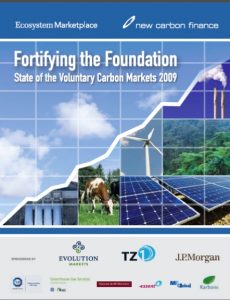Fortifying the Foundation
State of the Voluntary Carbon Markets 2009
By Katherine Hamilton, Milo Sjardin, Allison Shapiro, Thomas Marcello View PublicationThis report was created to answer fundamental questions about the voluntary carbon markets such as transaction volumes, credit prices, project types, locations, and the motivations of buyers in this market. Over the past several years, these markets have not only become an opportunity for citizen consumer action, but also an alternative source of carbon finance and an incubator for carbon market innovation. As the voluntary carbon markets have rapidly gained traction, the answers to these questions have become increasingly important to investors, policymakers, and environmentalists alike. For example, since the last edition of this report, we have seen various U.S. climate bills make reference to voluntary carbon offset standards, the Japanese government launch a voluntary carbon-offsetting scheme, and the U.K. government issue an official definition of “carbon neutral.”
Proving the legitimacy of carbon offset projects remains a major issue in the marketplace, leading to a so-called “flight to quality.” Last year saw further establishment and greater functionality of voluntary offset standards; the emergence of new registries; the forging of new partnerships between infrastructure providers; the formation of coalitions to encourage self-regulation; and increased market transparency. At the same time, existing and potential voluntary market consumers became more sophisticated as literature and education around offset quality increased. All of this points to a further maturation of the market in 2008. However, at the same time, the voluntary carbon markets, like any other commodity market, were not immune to the over-arching forces of the economy and regulatory developments.
This report is based on the information from over 182 suppliers from 28 different countries involving all stages of the supply chain: developers, aggregators, brokers, and retailers. We tracked 123.4 million metric tonnes of carbon dioxide equivalent (MtCO2e) transacted in the global voluntary carbon markets in 2008, a near doubling of 2007 transaction volume (87% growth). Of the two main components that comprise the voluntary carbon markets—the CCX and the OTC—the CCX was responsible for the larger share of the market. Of the 54.0MtCO2e transacted in the OTC market, we were able to confirm that only 12.4MtCO2e were retired. (Retirement is critical in the voluntary markets because it represents the impact of the market from an environmental perspective.)
We estimate that the voluntary carbon markets were valued at US$705 million in 2008, more than twice their value in 2007 (US$335 million).The average price of a voluntary carbon credit transacted on the OTC market was $7.34/tCO2e in 2008, up 22% from $6.10/tCO2e in 2007 and up 79% from $4.10/tCO2e in 2006.
Sources of voluntary offsets on both the CCX and the OTC market are extremely diverse in both project type and location. With regard to OTC project type, renewable energy credits dominated this year, increasing their market share from 27% in 2007 to 51%. Landfill gas capture was the second most popular category, mostly resulting from a shift towards pre-compliance motives in the U.S. carbon market.
Asia was the most popular project location; the largest single country supplying credits was the United States, which was the credit source for 28% of OTC transactions.
OTC credit prices in 2008 covered a wide range ($1.20 to $46.90/tCO2e), but not quite as wide a range as the year before ($1.80 to $300/tCO2e). Project types claiming the highest average prices in 2008 were renewable energy projects, of which solar, geothermal, and biomass energy claimed the highest spots.
The relevance of third-party verification to the voluntary carbon markets was solidified in 2008. No less than 96% of credits were third-party verified in 2008, up 9 percentage points from 2007. Last year also saw further consolidation amongst the many standards in the market.
A newer infrastructure element of the voluntary OTC market, but one that is receiving increasing attention, is the third-party credit-accounting registry. In 2008, at least 29% of voluntary transactions were tracked in a third-party registry. As of the publication of this report, there are at least 18 third-party registries serving the voluntary carbon markets.
Private companies continue to dominate the buy-side of the voluntary market (66% of volume), with purchasing for investment/resale now the largest overall motivation (35%) instead of retirement (29%). This suggests a higher contribution from intermediaries in the market.

